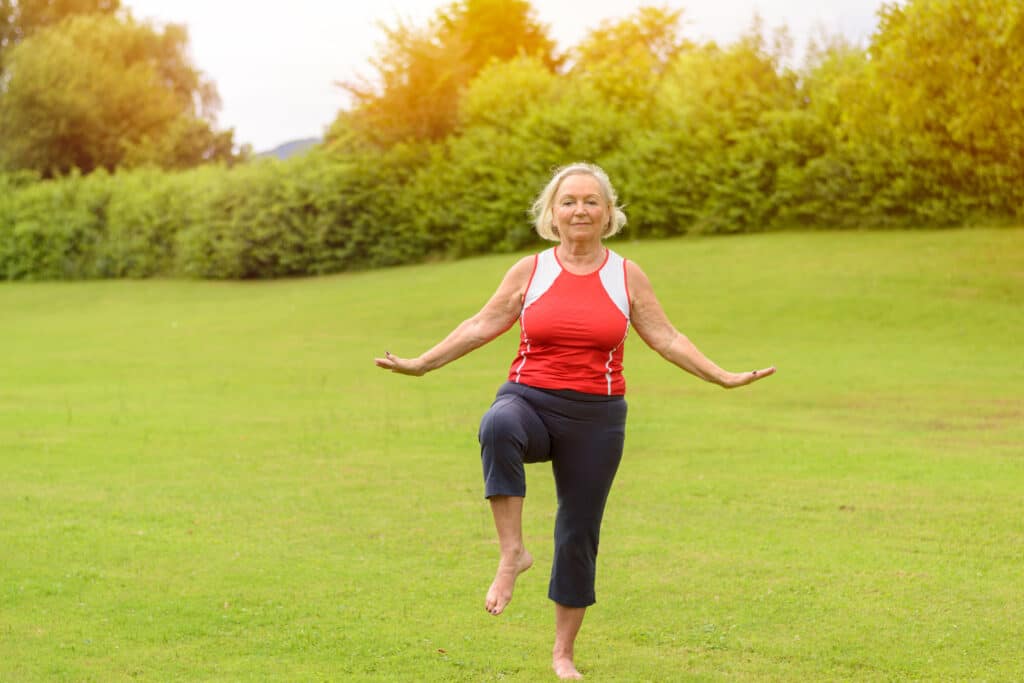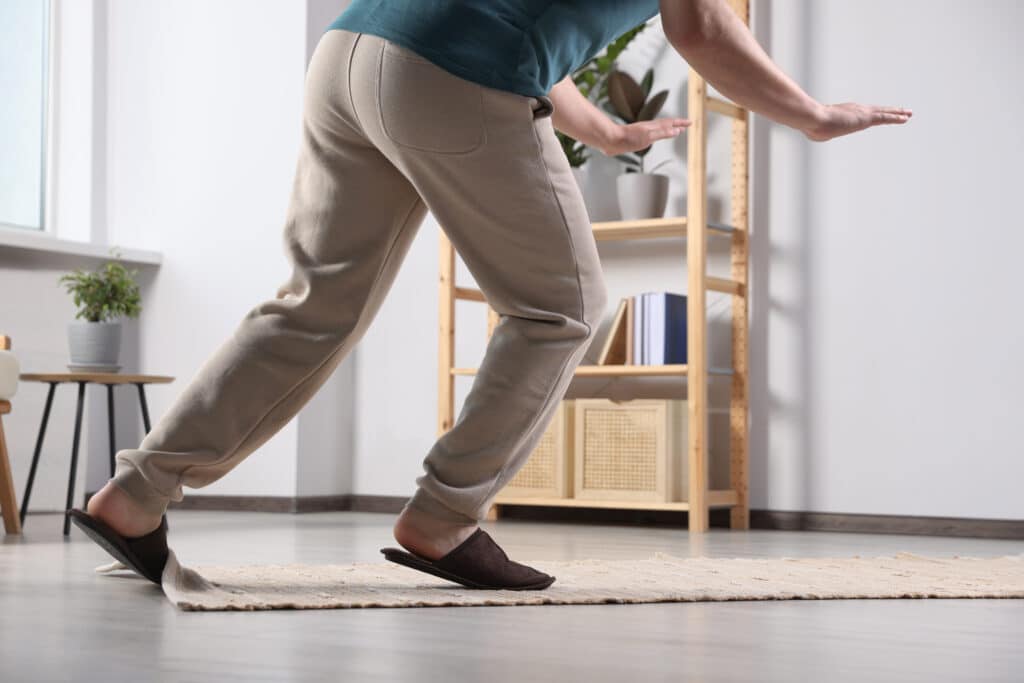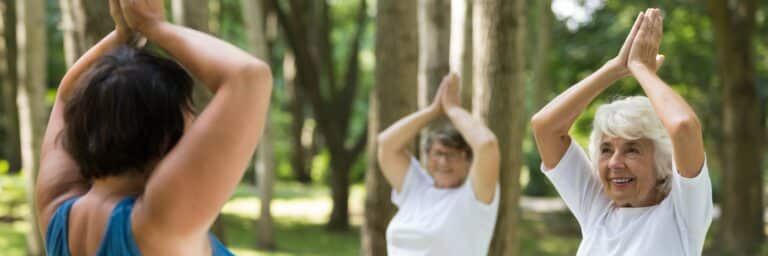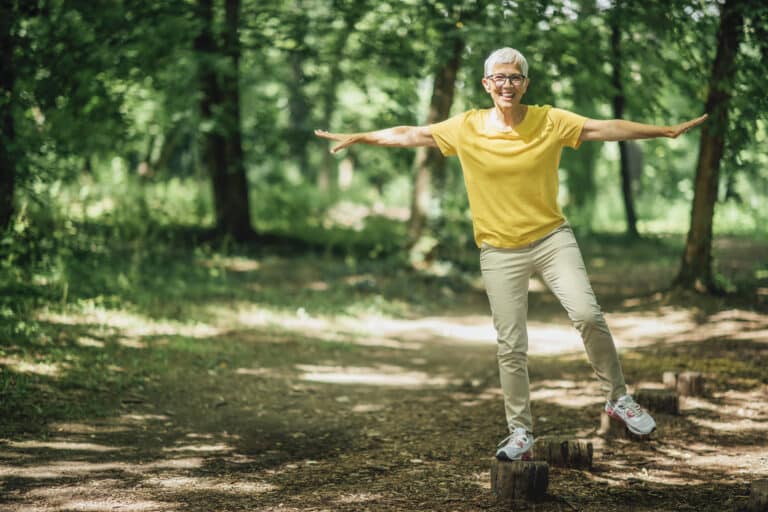Balance presents one of the biggest challenges in the daily lives of many seniors today. Various life circumstances and conditions can influence balance, equilibrium, and fall risk as we age.
Techniques like Reactive Balance Training can help prevent predictable falls and train your body and brain for the daily challenges that may not be so easy to predict.
What is Reactive Balance Training?
Reactive balance training is an exercise method designed to help you avoid falls by improving your balance reactions, like stepping quickly to prevent a stumble.
This type of exercise requires you to react quickly to something unexpected to keep your balance.
RBT involves using your whole body and helps strengthen and stabilize various muscles. More importantly, it improves your reaction time and stepping accuracy to help prevent future falls.1
Many older adults fall because of unexpected events, like slipping on a wet surface or tripping over something on the floor, such as a rug or power cord. Falls from slipping account for 40% of all outdoor falls among older adults.2
To recover from losing balance due to a slip or trip, you often need to take a large, quick step and shift your weight. Reactive balance training helps you practice these reactions so you can recover safely.
This training usually involves controlled simulations of unexpected forces that prompt a quick reaction. It can be done in several ways, such as having another person apply the force or using slip platforms.
For example, perturbation-based training is a common method for reactive balance training. It simulates the effect of a force acting on you, like someone bumping into you on a busy sidewalk.
The key to reactive balance training is that the force is unexpected, so you can’t prepare your response beforehand.
Who is Reactive Balance Training For?

RBT is for people who have trouble with their balance, have a history of falls, or are afraid of falling. A physical therapist usually guides it.
This training has been proven effective in reducing falls in patients with neurological conditions like Parkinson’s disease and stroke. It also helps reduce the fear of falling.
Reactive balance training is typically done in a physical therapy clinic with one-on-one supervision to ensure safety. Because this training is repetitive, it is best to do 2-3 sessions per week over several weeks for the best results.3
Remember, this training intentionally makes you lose your balance to practice recovery. It might seem scary initially, but doing it in a clinic with a trained professional can reduce the risk of falls during your workout and make you feel safer.
Physical Therapy for Reactive Balance
Physical therapists are trained professionals who can help improve your balance.
They use various safety precautions during balance training sessions, like support harnesses or gait belts, to catch you if you can’t recover on your own and prevent falls.
Repetition is a big part of reactive balance training. You’ll repeat activities until you can respond and recover your balance on your own. As you improve, the training can become more challenging to further enhance your reaction time and reflexes. Unlike traditional PT exercises focusing more on strength or flexibility, RBT focuses on quick reactions.
Your therapist may use different devices and equipment for training. Perturbation training is a common form of RBT. With limited equipment, your therapist can have you stand or walk and then purposely bump into you to trigger a balance reaction, like adjusting your posture or taking a step. This is done in a safe, controlled environment.
As you progress, you might stand on uneven surfaces like a wobble board, BOSU ball, or foam pad, and similar perturbations will be performed. Alternatively, the therapist might apply the force to the surface you’re standing on for a new challenge.
Slip Training
Some clinics may utilize more high-tech options for reactive balance training, such as a typical treadmill and/or a slip trainer. This harness system helps to support you from above to enhance your training and prevent injury.
Slip training can help to recreate more realistic slip-and-fall scenarios. With this training style, you might stand on a platform where the therapist can move unexpectedly, causing a step reaction. The harness is constructed to allow you to “fall” without the risk of hitting the ground with a force that might otherwise be dangerous.
Both treadmill and over-ground slip training have been shown to reduce the risk of falls more than traditional balance training.2
Reactive Balance Training at Home

Traditional reactive balance training with perturbations or slip training is not usually recommended for home use. However, you can still practice some exercises safely at home to improve your balance.
The main goal of these exercises is to strengthen step reactions and postural responses. Although it’s hard to simulate surprises at home, these exercises can support your training with your therapist.
When doing these exercises at home, ensure you are in a safe area to prevent injury. For instance, stand beside your bed or near a countertop or other sturdy surfaces to catch your balance if needed.
Please note: It’s best to practice these exercises when someone else is home with you in case of an accident or fall. Always talk to your doctor before starting new exercises.
Step Reactions
- Begin standing with a comfortable hips-width stance. Lean slightly forward while keeping the hips straight. You should start to feel your weight shift forward in your feet. Keep going until you have leaned too far outside your support base, forcing you to take a step to catch yourself.
- You can repeat this in each direction—forward, back, side-to-side, and diagonally — to practice step reactions in all planes. Be sure to give yourself enough space to take a large step in each direction.
- If you do not feel comfortable leaning outside your base of support, start by practicing large, quick steps in each direction from standing.
Alternating Lunges
- Start a comfortable stance. Take a large step forward, bending your knees into a lunge position. It is not necessary to bend your knees farther than is comfortable. Step your feet back together, then repeat on the other side.
- If you feel confident with this movement, you can repeat this exercise by stepping backward or side-to-side into a similar lunge position.
Balance & Reach
- Start standing with one foot before the other as if you have just taken a small step forward.
- Practice reaching in multiple directions — side-to-side, across your body, up or down. Try to maintain your balance as you reach in various directions with varying speeds.
- You can make this more challenging by standing on one foot while reaching or by narrowing your stance to a heel-to-toe position, like on a balance beam.
- You can also try having someone pass a balloon or a ball back and forth with you, causing the reaches to be more random, similar to the concept of perturbation training.
Other Options to Improve Balance
While these exercises mimic some of RBT’s benefits, many other exercises can also improve balance and prevent falls. Strength training and cardiovascular exercises are beneficial. Exercises like yoga and tai chi are particularly good for balance because they focus on coordination and deliberate movements.
If you’re new to these exercises, try moving slowly during your daily tasks to identify areas needing improvement. For example, when standing up from a seated position, avoid using your arms to push up; instead, rise slowly using your leg muscles. When sitting down, do it slowly to work the same muscles again.
Incorporating these simple actions into your day strengthens underworked muscles in the legs and hips, which are crucial for balance and other daily activities.
Additionally, managing health issues like high blood pressure, which can cause dizziness, is essential. By integrating balance exercises into your daily routine, you add another tool to prevent falls and serious injuries.
Key Takeaways
- Balance is a significant challenge for many seniors, influenced by various life circumstances and conditions.
- Reactive Balance Training (RBT) helps prevent falls by training quick responses to both predictable and unpredictable challenges.
- RBT involves exercises to improve balance reactions and stepping accuracy, critical for fall prevention.
- Common causes of falls include unexpected events like slipping or tripping, requiring large, quick steps, and weight shifts for recovery.
- RBT includes controlled simulations of unexpected forces to train quick reactions, often using perturbation-based training.
- Beneficial for those with balance issues, a history of falls, or fear of falling, RBT is administered by physical therapists and is effective for neurological conditions like Parkinson’s and stroke.
- RBT usually occurs in clinics, with safety precautions like support harnesses and gait belts. Repetition is crucial to improving reaction time.
- High-tech options like slip trainers and treadmills may be used to simulate slip-and-fall scenarios.
- While traditional RBT is not common for home use, complementary exercises like step reactions, alternating lunges, and balance and reach exercises can be practiced safely at home.
- Other exercises like strength training, yoga, and tai chi also improve balance and prevent falls.
- Daily tasks can be modified to serve as balance exercises, such as rising slowly from a seated position to engage leg and hip muscles.
FAQs
What is Reactive Balance Training (RBT)?
Reactive Balance Training (RBT) is a type of exercise designed to improve your balance and prevent falls. It trains your body to react quickly to unexpected events, helping you maintain stability and avoid stumbles.
Who can benefit from Reactive Balance Training?
RBT is beneficial for people who have trouble with balance, a history of falls, or fear of falling. It is also effective for individuals with neurological conditions like Parkinson’s disease and stroke, helping to reduce the risk of falls and the fear associated with them.
How does Reactive Balance Training work?
RBT involves exercises that require quick responses to unexpected forces or movements. These exercises help you practice the large, quick steps and weight shifts needed to recover from slips or trips. The training typically includes controlled simulations of these forces, like being bumped unexpectedly, to improve your reaction time and balance.
Is Reactive Balance Training safe to do at home?
Traditional RBT, which involves unexpected perturbations, isn’t usually recommended for home use due to safety concerns. However, you can safely practice complementary exercises at home, such as step reactions, alternating lunges, and balance and reach exercises. Always ensure you have a safe environment, like standing next to a bed or countertop, and consult your doctor before starting new exercises.
What kind of equipment is used in Reactive Balance Training?
RBT can use various equipment to simulate unexpected forces and ensure safety. This includes support harnesses, gait belts, slip trainers, treadmills, wobble boards, BOSU balls, and foam pads. These tools help create controlled environments where you can safely practice and improve your balance reactions.
How often should I do Reactive Balance Training for the best results?
To achieve the best results, it is recommended to perform RBT 2-3 times per week over several weeks. Consistent practice helps improve your reaction time and overall balance. A physical therapist typically supervises training sessions to ensure safety and effectiveness.
References
- Barzideh A, Marzolini S, Danells C, Jagroop D, Huntley AH, Inness EL, Mathur S, Mochizuki G, Oh P, Mansfield A. Effect of reactive balance training on physical fitness poststroke: study protocol for a randomized non-inferiority trial. BMJ Open. 2020 Jun 30;10(6):e035740. doi: 10.1136/bmjopen-2019-035740. PMID: 32606059; PMCID: PMC7328813.
- Wang, Y., Bhatt, T. Liu, X., Wang S., Lee, A., Wang, E., Pai, Yi-Chung. Can treadmill-slip perturbation training reduce immediate risk of over-ground-slip-induced fall among community-dwelling older adults? Journal of Biomechanics. 2019. Feb 14. 84(58-66). https://doi.org/10.1016/j.jbiomech.2018.12.017
- Avril Mansfield, Jennifer S. Wong, Jessica Bryce, Svetlana Knorr, Kara K. Patterson, Does Perturbation-Based Balance Training Prevent Falls? Systematic Review and Meta-Analysis of Preliminary Randomized Controlled Trials, Physical Therapy, Volume 95, Issue 5, 1 May 2015, Pages 700–709, https://doi.org/10.2522/ptj.20140090






